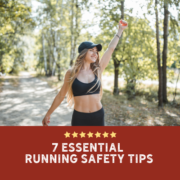7 Essential Running Safety Tips Every Athlete Should Know
Running outdoors offers many benefits, from exploring scenic trails to enjoying the vibrancy of a bustling cityscape. It’s an exhilarating way to stay fit, meet fellow runners, and breathe in the fresh air of nature or urban life. Ensuring safety during your runs is important, whether you’re sprinting a short distance on a local track or embarking on a long trail run. Here are 7 safety tips that will help keep your running sessions just as safe as they are enjoyable.
1. Running with a Friend for Enhanced Safety
Running with a companion isn’t just a fun way to pass the miles; it’s a strategic safety decision. W hen you run with a friend, you’re more visible to vehicles and less likely to be targeted by criminals. In the unfortunate event of an accident or health issue, having a buddy means quicker access to help. Moreover, training with a friend keeps you accountable and motivated. If you’re struggling to convince someone to join you, remind them of these safety benefits – they just might lace up their running shoes!
hen you run with a friend, you’re more visible to vehicles and less likely to be targeted by criminals. In the unfortunate event of an accident or health issue, having a buddy means quicker access to help. Moreover, training with a friend keeps you accountable and motivated. If you’re struggling to convince someone to join you, remind them of these safety benefits – they just might lace up their running shoes!
2. Importance of Listening to Your Surroundings
While a high-energy playlist can be a runner’s best friend, it’s crucial to remain aware of your surroundings. If you prefer running with earbuds, consider keeping one out. Alternatively, keep the volume low or switch to playing music out loud. This balance allows you to enjoy your tunes while staying alert to the sounds around you, be it approaching vehicles or other potential hazards.
3. Staying Safe by Running Against Traffic
Visibility is key when it comes to running safety. Running against traffic enhances your ability to see oncoming vehicles and allows drivers to spot you well in advance. Be mindful of blind corners and plan your route to avoid these areas. Especially as you increase your distance, ensuring you’re always running against traffic can make a significant difference in your safety.
4. The Role of Reflective Clothing in Runner Safety
As the day fades into night, visibility becomes even more crucial. Wearing reflective clothing dramatically increases your visibility to drivers, cyclists, and other runners. Consider enhancing your visibility with headlamps or lightweight lights which can be worn on your arms, shoes, or ankles. These simple additions to your running attire can be lifesaving, especially during early morning or nighttime runs.
5. Why Carrying Your Phone is a Lifesaver
In today’s digital age, your phone is much more than a device for music or tracking your route. It’s a crucial tool for safety. Ensure your phone is fully charged before heading out, so you’re prepared in case of an emergency. For a hassle-free experience, carry your phone in a SPIbelt, available in various sizes and colors, ensuring it’s always within reach.
6. Informing Someone About Your Run for Added Security
Before you hit the pavement, make it a habit to inform someone about your running plans. Share your route, expected mileage, and estimated return time with a trusted individual. Activate the location-sharing feature on your smartphone for added peace of mind. Not only does this keep someone informed, but it also adds an extra layer of security to your run.
7. Maintaining Proper Hydration and Nutrition
Maintaining proper hydration and nutrition isn’t just crucial for performance; it’s a significant safety measure for runners. Dehydration and nutrient deficiencies can lead to disorientation, fatigue, and even serious health issues, especially during long runs or in extreme weather conditions. Always start your run well-hydrated and consider carrying a water bottle or planning a route with water stations. For longer distances, bring along energy gels or snacks to keep your glycogen levels stable. Understanding your body’s needs and preparing accordingly can prevent unexpected health problems and ensure a safe and successful run.
By integrating these 7 safety tips into your running routine, you significantly boost your chances of a secure and enjoyable running experience. Whether you’re a seasoned marathoner or a casual neighborhood jogger, safety should always be your top priority. Remember, the best runs are not only measured by distance or time but by how safely you return home. So, stay safe, stay visible, and keep on running!



